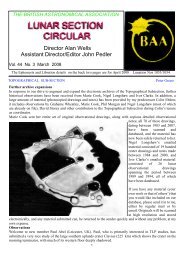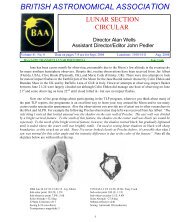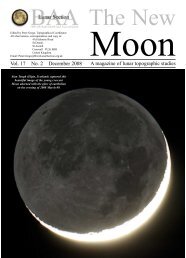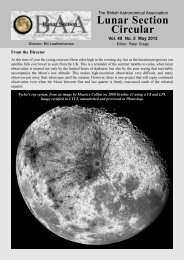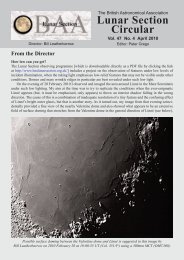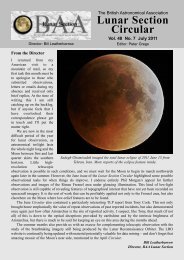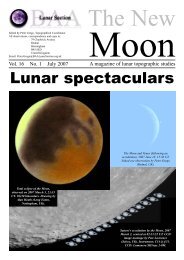Vol 50, No 4, April 2013 - BAA Lunar Section
Vol 50, No 4, April 2013 - BAA Lunar Section
Vol 50, No 4, April 2013 - BAA Lunar Section
- No tags were found...
You also want an ePaper? Increase the reach of your titles
YUMPU automatically turns print PDFs into web optimized ePapers that Google loves.
Director: Bill LeatherbarrowThe British Astronomical Association<strong>Lunar</strong> <strong>Section</strong>Circular<strong>Vol</strong>. <strong>50</strong> <strong>No</strong>. 4 <strong>April</strong> <strong>2013</strong>Editor: Peter GregoFrom the DirectorThe Triesnecker RillesOn the evening of 17 February <strong>2013</strong> I was able to make an observation of sunrise over the Triesnecker rillesystem in reasonably good seeing conditions (Ant. III-II). I used a 12-inch Mak-Cass to take the image shownin Fig. 1, along with a DMK21 mono camera and an IR filter. The time was 18:23 UT and the colongitudewas 356.65°.Fig. 1. Triesnecker-Hyginus, imaged by Bill Leatherbarrow on <strong>2013</strong> February 17.
The area covered by the image (which is north up) offers a potted lesson in different types of rille. To theeast can be seen the western end of the Ariadaeus rille, which is one of the finest examples on the Moon of agraben-like structure, where land has slumped between parallel faults. The nearby Hyginus rille, however,betrays evidence of volcanism in its creation, in the form of rimless collapse pits along its length.Interestingly, the eastern branch of the Hyginus rille follows the same general orientation as the Ariadaeusrille, and a fainter branch continues in that same direction west of Hyginus itself. However, the moreprominent branch on the western side of Hyginus strikes off in a direction that tends towards the Imbriumimpact basin.The rilles making up the complex system to the east of Triesnecker are different again. These look for allthe world like fractures associated with ground undulations in this area that become visible only underextremely low illumination. In particular, Fig. 1 shows a shadow-filled trough just to the north of Triesneckerwith apparently uplifted terrain to either side of it. This interpretation is born out by a west-east LROCelevation profile of the area (Fig. 2).Fig. 2. West-East profile north of Triesnecker.It seems likely that theTriesnecker rille system is theresult, at least in part, offracturing of the surfaceresulting from theseundulations. I think PhilMorgan made a similarsuggestion in the LSC sometime back, and there is a finedrawing by him in the May2010 LSC (<strong>Vol</strong>. 47, <strong>No</strong>. 5, p.4). This was made under verysimilar lighting to my image,and it also clearly shows theuplifts and trough. Detail fromPhil’s observation is shown inFig. 3 at right).It would be good to getsome images of this area undersunset illumination.Bill LeatherbarrowDirector, <strong>BAA</strong> <strong>Lunar</strong> <strong>Section</strong>Fig. 3.2
An astronaut’s view of Triesnecker and Rimae TriesneckerEditor’s note: Part of an Apollo 10 northwestward oblique view of Triesnecker crater, centred near 3.6°Elongitude and 4°N latitude, taken from the Command and Service Modules. Terrain features typical ofnortheastern Sinus Medii are shown. Beyond the highlands, the smooth floor of Mare Vaporum extendsalmost to the horizon some 600 km from the spacecraft. Triesnecker crater, about 27 km in diameter, was135 km northwest of Apollo 10 when the picture was taken. The Rimae Triesnecker are well shown, as arenumerous dorsa and smaller sinuous rilles. Image: AS10-32-4819 (1969 May 18-26).<strong>BAA</strong> <strong>Lunar</strong> <strong>Section</strong> Circular <strong>Vol</strong>. <strong>50</strong> <strong>No</strong>. 4 <strong>April</strong> <strong>2013</strong> 3
Topographical notescompiled by Peter GregoVisual studies and observationsSince March’s <strong>Lunar</strong> <strong>Section</strong> Circular, visual topographic lunar observational drawings have been receivedfrom Phil Morgan (Tenbury Wells, UK), Chuch Hastorf (Arizona, USA) and Dale Holt (Chipping, UK).See also Bill Leatherbarrow’s image taken around the same time (p7) and Tony Cook’s TLP report.4<strong>BAA</strong> <strong>Lunar</strong> <strong>Section</strong> Circular <strong>Vol</strong>. <strong>50</strong> <strong>No</strong>. 4 <strong>April</strong> <strong>2013</strong>
<strong>BAA</strong> <strong>Lunar</strong> <strong>Section</strong> Circular <strong>Vol</strong>. <strong>50</strong> <strong>No</strong>. 4 <strong>April</strong> <strong>2013</strong> 5
Piccolomini<strong>2013</strong> March 3104:30 UT<strong>50</strong>5 mm Newtonian, 2x BarlowWatec120N vidcamDale HoltAfter deciding upon Piccolomini, I added a 2xBarlow to increase the magnification and got onwith my drawing. I’m constantly drawn to thecircle of craters that so much reminds me of anold fashioned telephone dial.Drawing made on A5 Black 270gsm PinkPig art paper, using conte, pastels, pastelpencils, water colour pencils and white acrylicpaint.Archimedes area Chuck Hastorf<strong>2013</strong> March 410:30-13:30 UTCol. 176.9°Lib. lat: -04.36°Lib. lon: -01.27°NexStar 8SE (SCT), 127x, 290xScanning the sunset terminator heading northtoward Plato, I was arrested by the stunningshadows of Aristillus and Autolycus. I beganmy field sketch. The more that I got into thesketch the moreinterested I becamewith the very subtlemarkings on the floorof Mare Imbrium.This area contains afascinating collectionof remnants of craterdebris and faint hintsof long flooded anderoded ancientcraters. A difficultchallenge but worththe effort.Because of poorseeing conditions Ihave had a lot of timeto work on the finaldrawing instead ofviewing. Finaldrawing made usinga Wacom Bambootablet and SketchBook Pro software.6<strong>BAA</strong> <strong>Lunar</strong> <strong>Section</strong> Circular <strong>Vol</strong>. <strong>50</strong> <strong>No</strong>. 4 <strong>April</strong> <strong>2013</strong>
Full Moon over Wellingtonhttps://vimeo.com/58385453From Bob Garfinkle:A non-astronomy friend sent this video to me. Beautiful. Pass it along to your friends. Interestingto see the Moon rise ‘upside down’.Here is something a bit random, but none-the-less astounding. Aphotographer captured what is, to me, one of the mostremarkable things I have ever seen filmed. It is a 3 minutevideo clip of the full moon rising over Wellington, NewZealand. It was shot <strong>2013</strong> January 28, a calm summerevening, as people gathered on the Mt. Victoria Lookoutpoint to watch the moon rise. This stunning video is onesingle real-time shot, with no manipulation whatsoever. Thecamera was placed on a hillside over 2 kilometres from theLookout point, and was shot with the equivalent of a 1300mmlens. The amount of planning, trial and error, and luck that wentinto this are mind blowing. One thing I encourage you to do is watchthis on the biggest screen you have — don’t waste it on an iphone screen. Ihope you all enjoy this as much as I did.<strong>Lunar</strong> imagesSince March’s LSC, lunar images (or links to images) have been received from Mike Brown (York, UK),Maurice Collins (New Zealand), David Finnigan (UK), Richard Hill (USA), Bill Leatherbarrow (Sheffield,UK), Damian Peach (Selsey, UK), David Scanlan (Romsey, UK). A selection of these images is featuredbelow. My apologies to those contributors whose hard-won work is not featured in this issue; limited spacemeans that only a sample of material (with preference to <strong>BAA</strong> members) is included.Ptolemaeus andAlphonsus, imaged byBill Leatherbarrow on<strong>2013</strong> February 18 at18:37:25 UT, Col. 8.9°.12-inch MCT.<strong>BAA</strong> <strong>Lunar</strong> <strong>Section</strong> Circular <strong>Vol</strong>. <strong>50</strong> <strong>No</strong>. 4 <strong>April</strong> <strong>2013</strong> 7
Grimaldi, imaged byDamian Peach on2012 December 26 at19:22 UT.8<strong>BAA</strong> <strong>Lunar</strong> <strong>Section</strong> Circular <strong>Vol</strong>. <strong>50</strong> <strong>No</strong>. 4 <strong>April</strong> <strong>2013</strong>
Hevelius, imaged by Damian Peachon 2012 December 26 at 19:15 UT(detail below).<strong>BAA</strong> <strong>Lunar</strong> <strong>Section</strong> Circular <strong>Vol</strong>. <strong>50</strong> <strong>No</strong>. 4 <strong>April</strong> <strong>2013</strong> 9
Larrieu’s Dam’Richard BaumThe interesting little note about the lunar feature Polybius K in the March <strong>2013</strong> issue of Sky and Telescopethough a timely reminder to be watchful when exploring the topography of our satellite, is slight in its detailof how the formation came to public notice. Nigel Longshaw has given us a fuller account in his definitivepaper published in the Journal of the British Astronomical Association 118 [2] 87-90 (2008), Larrieu’s Dam:the ‘rediscovery’ of a seldom explored topographical lunar feature in the foothills of the Rupes Altai. In viewof this revival, I thought sight of the original historical material might be of interest to <strong>Section</strong> members. NigelLongshaw reproduced the drawings in his paper, but not the textual matter.The observation came to our notice, and here I speak in terms of my late wife and myself, as editors of anews bulletin Vega, from a subscriber, a Mr. A. C. Larrieu, resident in Marseilles, France. Here I give MrLarrieu’s letter plus his sketches, plus the report that featured in Vega <strong>No</strong>. 26 (1956) along with associateddocuments so the <strong>Section</strong> can have the complete historical record for its archive.A.C. Larrieu’s original letter to Richard Baum, editor of Vega.10<strong>BAA</strong> <strong>Lunar</strong> <strong>Section</strong> Circular <strong>Vol</strong>. <strong>50</strong> <strong>No</strong>. 4 <strong>April</strong> <strong>2013</strong>
A.C. Larrieu’s original observationof the feature (right), along with hissketch based on a Lick Observatoryphotograph (below).Below: Contemporary notes on‘Larrieu’s Dam’ by Richard Baum.<strong>BAA</strong> <strong>Lunar</strong> <strong>Section</strong> Circular <strong>Vol</strong>. <strong>50</strong> <strong>No</strong>. 4 <strong>April</strong> <strong>2013</strong> 11
This page and overleaf: ‘Breaking news’ of ‘Larrieu’s Dam’ was featured in Vega, 1955 August 29, apublication edited by Richard Baum.12<strong>BAA</strong> <strong>Lunar</strong> <strong>Section</strong> Circular <strong>Vol</strong>. <strong>50</strong> <strong>No</strong>. 4 <strong>April</strong> <strong>2013</strong>
<strong>BAA</strong> <strong>Lunar</strong> <strong>Section</strong> Circular <strong>Vol</strong>. <strong>50</strong> <strong>No</strong>. 4 <strong>April</strong> <strong>2013</strong> 13
14<strong>BAA</strong> <strong>Lunar</strong> <strong>Section</strong> Circular <strong>Vol</strong>. <strong>50</strong> <strong>No</strong>. 4 <strong>April</strong> <strong>2013</strong>
<strong>BAA</strong> <strong>Lunar</strong> <strong>Section</strong> Circular <strong>Vol</strong>. <strong>50</strong> <strong>No</strong>. 4 <strong>April</strong> <strong>2013</strong> 15
Rik Hill writes: Ever since I read Patrick Moore’s book The Moon, as a teenager in the 1960s, I have beenfascinated by the region of Sinus Medii and Mare Vaporum. This image of that region is with a little higher Sunthat what is usually done. There are many things going on here that cannot be seen with the typical terminatorlighting. The rilles can still be seen in all their glory. The Triesnecker, Hyginus, Ariadaeus and Boscovich rillsystems are well seen across the image. But what I find more interesting are the dark patches in the region. Fromthe area just east of Triesnecker E, to the area just south of Hyginus, the area Hyginus S sits in, to Boscovichand the unusual dark region in Julius Caesar, all are interesting and tell a story of the history of this reagion. Thelayered nature of the interior of Julius Caesar seems to imply altitudinal differences like a slope change fromlow to high as one moves north to south. I also like the ray system about Dionysius which is often lost amongall the features of this area. The images from my camera were stacked using Registax6 and then processed withIrfanView and GIMP. Final montage assembly of the 6 images was done with AutoStitch.16<strong>BAA</strong> <strong>Lunar</strong> <strong>Section</strong> Circular <strong>Vol</strong>. <strong>50</strong> <strong>No</strong>. 4 <strong>April</strong> <strong>2013</strong>
<strong>BAA</strong> <strong>Lunar</strong> <strong>Section</strong> Circular <strong>Vol</strong>. <strong>50</strong> <strong>No</strong>. 4 <strong>April</strong> <strong>2013</strong> 17
18<strong>BAA</strong> <strong>Lunar</strong> <strong>Section</strong> Circular <strong>Vol</strong>. <strong>50</strong> <strong>No</strong>. 4 <strong>April</strong> <strong>2013</strong>
Transient lunar phenomena, <strong>April</strong> <strong>2013</strong>Tony CookObservations for February were received from the following observers, and Brendan Shaw has been especiallyactive: Jay Albert (Lake Worth, FL, USA - ALPO) observed: Aristarchus, earthshine, Hyginus, Mons Pico, Poisson,Proclus, and Snellius. Maurice Collins (New Zealand - RASNZ) observed: Aristarchus, Bullialdus, Copernicus,Mare Humorum, Pythagoras, Mons Rumker, Schickard, and imaged several features. Marie Cook (Mundesley,UK) observed Cepheus A, Proclus, Theophilus, Mare Angius, and Plato. Rik Hill (Tucson, AZ, USA) imaged:Archimedes, Anaxagoras, Clavius, Copernicus, Triesnecker, and Plato. Bill Leatherbarrow (Sheffield, UK) imagedthe Lassell area. Phil Morgan sketched: Lassell. Brendan Shaw (UK) imaged: Agrippa, Alphonsus, Atlas, Birt, Biot,Censorinus, Cepheus A, Clavius, Conon, Copernicus, Eudoxus, Gutenberg, Jansen, Linne, Macrobius, MareAngius, Mare Crisium, Mons Piton, Plato, Posidonius, Proclus, Ross D, Swift, Theophilus, and Tycho. We alsoreceived some additional observations from January, of Promontorium Agarum, from Italian observers: ClaudioVantaggiato (UAI) and Franco Taccogna (UAI).News: An interesting paper on TLP frequency and the sunspot cycle, by Jill Scambler, appeared in last month’s<strong>BAA</strong> <strong>Lunar</strong> <strong>Section</strong> Circular. This dispelled the idea, from a 1945 paper by H.P. Wilkins, that TLP frequencycorrelate with the solar cycle. Three independent methods were used to test this theory, and all three came backnegative. It also used more up-to-date TLP reports than were available in Wilkins time. Of course it does not meanthat at least some processes on the Moon cannot be influenced by solar activity, for example charging of dustparticles is expected to increase during high solar activity. But as a main cause, driver of TLP, there is no evidencethat the Sunspot cycle influences this with measurable significance.TLP Reports: <strong>No</strong> TLP reports were received in February, although it’s worth mentioning a couple of reports thatcame to light, one of which we are sure is not a TLP, and the other maybe, or maybe not?:Lassell: Peter Grego found a wrinkle ridge adjacent to this crater in a sketch (Fig. 1a) drawn by Phil Morgan, thatPeter had not noticed previously in his own sketches (Fig. 1e) made under similar illumination. As we all knowPeter Grego is a very careful and skilled observer, so the Morgan observation needed further investigation. BillLeatherbarrow had been observing that night too and submitted an image (Fig. 1b) which sort of shows this ridge,and I came across a Harold Hill sketch too (Figure 1d). Just as an independent check, I ran (Figure 1c) an ALVISsimulation (a similar lunar crater visualization tool can be found at: http://ltvt.wikispaces.com/LTVT+Download )for the start of Peter’s sketch. The ridge concerned is part of a broad NW-SW trending wrinkle ridge. As this isshallow, it is difficult to see, and does not have a well defined sharp edge. When making sketches, of very finedetail, through the Earth’s turbulent atmosphere, with a wealth of other detail also to map, it is not always possibleto portray accurately everything, and some detail may not always be noticed, if it is on the limit of visibility underthose observing conditions. It is not just this highlighted ridge seen in the sketches and images in Fig. 1, but otherfeatures in and around the crater also differ too when you compare sketches with an image or a simulation. Forexample in Harold Hill’s sketch the ridge is light, whereas in the Phil Morgan sketch it is dark? Sketches have beenthe main observing technique in the past tens of decades, and are still useful as it is more often than not, during avisual session that TLPs are detected – images are often obtained over a very short time period, and may not bestudied by the human eye as much as a real live view of the Moon at the eyepiece. So sketches are good, but aswith images, more subtle low contrast detail needs to be treated cautiously.Plato: I forgot to mention in the past newsletter, that I had received an observation from Raffaello Braga (Italy,Milan, 115mm refractor) from <strong>2013</strong> Jan 25 UT 19:05-10:15 where he noted the crater to be: “overall normal, butE. Rim showing a remarkable gold hue”. This was at a similar illumination to a W.E. Fox TLP report from 1938Feb 14 where he noted a golden-brown spot on the E. Wall with a yellow diffuse glow, spreading over the floor.<strong>No</strong>w I emailed Raffaello to ask him if he thought what he observed in Jan could be regarded as a TLP, but hecommented: “I must say that the yellow-gold hue was remarkable. Would I have noticed this colour withoutknowing in advance the above report? May be not, so I would not consider it as abnormal, but in my opinion thisappearance is worth of further investigations”. In order to help promote future observations of this, and to see if itrepeats, I will give this observation a TLP weight of 1, so that it shows up in the system. If Raffaello is correct thenit should presumably happen again at predicted times, in which case we can demote it to a non-TLP status with aweight of 0, and the cause would have been due to natural surface colour.<strong>BAA</strong> <strong>Lunar</strong> <strong>Section</strong> Circular <strong>Vol</strong>. <strong>50</strong> <strong>No</strong>. 4 <strong>April</strong> <strong>2013</strong> 19
Figure 1. Lassell crater with north towards the top left. a) A sketch by Phil Morgan from <strong>2013</strong> Feb 18UT 18:20-18:45, Col.= 8.9°-9.1°. b) An image by Bill Leatherbarrow from <strong>2013</strong> Fe b 18 UT 18:37,Col.= 9.0°. c) An ALVIS simulation for 2010 May 21 UT 20:25, Col.= 10.5° to match the start of PeterGrego’s initial sketch. d) A Harold Hill sketch from 1988 Feb 25 UT22:<strong>50</strong>-23:45, Col.= 10.4°-10.9°. e)Peter Grego’s sketch from 2010 May 21 UT 20:25-20:<strong>50</strong>, Col.=10.5°-10.7°) – the yellow arrows showswhere the NW-SE trending ridge should have been.Routine Reports: Here is a selection of reports received during February that can help to re-assess some pastTLP observations:Poisson: On <strong>2013</strong> Feb 18 UT 02:41-02:51 Jay Albert observed Poisson under the same illuminationconditions to a 1982 report listed below. Jay found the crater to be bright and its “lima bean” shape was easilyseen. It was not hazy and there was no obscuration. Many internal and peripheral details were clearly seen.Because Poisson, was quite degraded, Jay wondered if this was why the TLP observer thought it was hazy.The small size of the telescope used in 1982 possibly did not help either. As we do not have more than thedescription given below from the Cameron catalog, it is difficult to assess if the, weight, already a 1, deservesa demotion to non-TLP status. Nevertheless it was worth checking out in future.“On 1982 Aug 26 at UT 21:00 Arsyukhin (Moscow, Russia, 3” reflector) found that Poissonappeared hazy. The Cameron 2006 catalog ID=181 and weight=3. The ALPO/<strong>BAA</strong> weight=1.”20<strong>BAA</strong> <strong>Lunar</strong> <strong>Section</strong> Circular <strong>Vol</strong>. <strong>50</strong> <strong>No</strong>. 4 <strong>April</strong> <strong>2013</strong>
Cleostratus-Pythagoras: On <strong>2013</strong> Feb 23 UT 08:54 Maurice Collins imaged (see Fig. 2) this area undersimilar illumination to a TLP report from Chris Lord from 1974 – see below. The image was colour enhanced,but no sign of the surface being brighter in the areas referenced in the report was seen. The fact Chris Lordused standard Moon Blink Kodak Wratten filters, these should eliminate both spectral dispersion from theatmosphere, or from the optics. The large lunar altitude should preclude the atmospheric spectral dispersionanyway. The weight for this TLP report shall therefore remain at 3 as there was no independent confirmationobservation.1974 Feb 05 UT 01:45,02:45observed by Lord (St Anne’son-Sea,Eng., 3” refractor,x135, seeing I, lunaraltitude 55°) “Event normalin integrated light. Light,full surface detail in redfilter, dark, with fullsurface detail in bluefilter. Other term. featuresdid not show it. OnlyE.floor of Pythag., Babbagenorthern crater chain & NWfloor of Cleostr. (Accordingto Fitton’s criteria thiswas a tenuous gas above thesurface. NASA catalogweight=3. NASA catalogID=#1387. ALPO/<strong>BAA</strong> weight=3.Figure 2. The Pythagoras area, imaged by Maurice Collins on <strong>2013</strong>Feb 23 UT 08:54. <strong>No</strong>rth is towards the top and colour saturation hasbeen enhanced to 60%.Cepheus A: On <strong>2013</strong> Feb 16 UT 19:35-19:<strong>50</strong> Marie Cook observed Cepheus A under the same conditions towhen Maurice Collins saw it in 2000 Oct 04. Brendan Shaw also observed the crater and obtained an imageat 19:40 UT (see Fig. 3). Both these observations confirm that Cepheus A was not very brilliant crater asMaurice Collins reported back in 2000. Marie found it to have the same brightness as Maury crater. In viewof the discrepancy in reported brightness, between these different epochs, and numerous attempts to reobserveand nothing unusual beingseen, I have decided to promotethe weight of the Maurice Collinsreport from a 2 to a 3.2000 Oct 04 UT 08:15-08:<strong>50</strong>Observer: Maurice Collins(New Zealand, 90cm ETX) -observer noted that craterwas extremely bright -wasn’t sure if this wasnormal and at the time ratedit as the brightest(contrasty?) crater that hehad ever seen on the Moon.ALPO/<strong>BAA</strong> weight=2.Figure 3. The Cepheus A area asimaged by Brendan Shaw on <strong>2013</strong>Feb 16 UT 21:16 UT. Thecraterlet is to the left of theyellow marker. <strong>No</strong>rth is towardsthe top.<strong>BAA</strong> <strong>Lunar</strong> <strong>Section</strong> Circular <strong>Vol</strong>. <strong>50</strong> <strong>No</strong>. 4 <strong>April</strong> <strong>2013</strong> 21
Plato: On <strong>2013</strong> Feb 20 UT 02:25 Rik Hill imaged Plato at almost the same illumination as a report from da Silvafrom 1970 Apr 15. As you can see, Plato Y is perhaps not especially brighter than its surroundings (it dependsupon which part of it one refers to), and the landslip area, alias the “lozenge” shape, is dark, but not necessarilymore so than the inner wall. Unfortunately no colour information is present in Rik’s image, so it is not possibleto check for the 1970s report of a yellow-white on the bright part of the wall. There is some difference indescriptions of what was seen between 1970 and <strong>2013</strong>, so it might be a TLP? However as da Silva considers itto be normal, I will keep this at a very low weight of 1. The yellow white colour seen perhaps is natural colourand might be related to what Raefello Braga and W.E. Fox both saw? So please keep a look out in this area forcolour in future.Near and on Plato 1970 Apr15 UT 21:45-22:04 Observedby da Silva (Sao Paulo,Brazil, 10” & 20”refractors) “Crater chain W.of Plato — 3rd crater W.(Plato Y) was brighter thansurroundings. Lozenge on W.Wall (landslip?) was darkerthan inner wall. Bright partof wall was yellowish-white.da Silva reports this asneg. (normal aspects)obs(Apollo 13 watch probablynormal as Y is a bright halocrater).” NASA catalogweight=0. NASA catalog ID#1255. ALPO/<strong>BAA</strong> weight=1.Figure 4. Plato as imaged by Rik Hill on <strong>2013</strong> Feb 20 UT 02:25 withnorth towards the top. Areas mentioned in the 1970 TLP are indicated.Suggested Features to observe in <strong>April</strong>: For those of you without access to the internet (in the UK), belowis a list of repeat conditions for when a feature will exhibit the same illumination and libration as was seenfor a historical TLP observation from the past. By re-observing and submitting your observations, we will geta clear understanding of what the feature ought to have looked like at the time. Only this way can we reallyfully analyze past TLP reports.<strong>2013</strong>-Apr-13 UT 18:58-20:30 Ill=11% West Limb observed by Haywood on 1884-03-29: Can you see(small scopes allowed) a misty looking light on the dark limb?<strong>2013</strong>-Apr-13 UT 19:40-20:08 Ill=11% Earthshine - Look for impact flashes from sporadic meteors.<strong>2013</strong>-Apr-14 UT 19:40-22:44 Ill=17% Aristarchus – observed by da Silva on 1971-07-28: Can you see 2bright points inside Aristarchus on the night side?<strong>2013</strong>-Apr-14 UT 19:42-21:00 Ill=18% Earthshine - Look for impact flashes from sporadic meteors.<strong>2013</strong>-Apr-15 UT 19:44-21:48 Ill=26% Earthshine - Look for impact flashes from sporadic meteors.<strong>2013</strong>-Apr-16 UT 19:45-22:30 Ill=35% Earthshine - Look for impact flashes from sporadic meteors.<strong>2013</strong>-Apr-17 UT 19:47-23:06 Ill=44% Earthshine - Look for impact flashes from sporadic meteors.<strong>2013</strong>-Apr-21 UT 01:19-02:08 Ill=74% Hevelius observed by Emett on 1826-04-17: Please sketch or imagethis feature.<strong>2013</strong>-Apr-21 UT 19:12-22:02 Ill=81% Mare Crisium observed by Williams on 1881-05-09: Please sketchor image this feature, in particular looking out for streaks and spots on the floor of the mare.22<strong>BAA</strong> <strong>Lunar</strong> <strong>Section</strong> Circular <strong>Vol</strong>. <strong>50</strong> <strong>No</strong>. 4 <strong>April</strong> <strong>2013</strong>
<strong>2013</strong>-Apr-21 UT 19:12-22:02 Ill=81% Gassendi observed by Spencer on 1976-04-10: Any colour on the SWwall?<strong>2013</strong>-Apr-21/22 UT 21:17-00:23 Ill=82% Posidonius observed by Dzaplashvili on 1952-07-03: Pleasestudy or image through a rotating Polaroid filter.<strong>2013</strong>-Apr-21/22 UT 23:05-02:30 Ill=82% Proclus observed by Bartlett on 1959-03-21: Please sketch orimage the interior.<strong>2013</strong>-Apr-22 UT 01:51-02:30 Ill=83% Torricelli B observed by <strong>No</strong>rth on 1995-04-11: Can you see or imageany colour in the crater, and how bright is Torricelli B compared to other similar sized craters?<strong>2013</strong>-Apr-25 UT 20:08-23:19 Ill=100% Moon observed by Le Croy– Please image the Moon so thatDelambre, Manilius, and Menelaus can be compared in appearance/brightness to what they were describedas during a lunar eclipse.For repeat illumination (only) TLP predictions for the coming month, these can be found on the followingweb site: http://users.aber.ac.uk/atc/tlp/tlp.htm .For members who do not have access to the internet, pleasedrop me a line and I will post predictions to you. If you would like to join the TLP telephone alert team, pleaselet me know your phone <strong>No</strong>. and how late you wish to be contacted. If in the unlikely event you see a TLP,please give me a call on my cell phone: +44 (0)798 <strong>50</strong>5 5681 and I will alert other observers. <strong>No</strong>te whentelephoning from outside the UK you must not use the (0). When phoning from within the UK please do notuse the +44! Twitter TLP alerts can be accessed on http://twitter.com/lunarnaut.Dr Anthony Cook, Institute of Mathematical and Physical Sciences, University of Wales Aberystwyth,Penglais, Aberystwyth, Ceredigion, SY23 3BZ, Wales, United Kingdom.Email: atc(at)aber.ac.uk<strong>BAA</strong> <strong>Lunar</strong> <strong>Section</strong> Circular <strong>Vol</strong>. <strong>50</strong> <strong>No</strong>. 4 <strong>April</strong> <strong>2013</strong> 23
Occultation news, <strong>April</strong> <strong>2013</strong>Tim HaymesObservation of double starsAlex Pratt (Leeds) reports a double star observation in February. Alex writes that video analysis of 7thmagnitude SAO 94031 (on <strong>2013</strong> Feb 18, 19:00 UT) indicated overexposed at 25 fps to the point of saturation(Fig. 1a). This prevented correct photometric measurements of the star using TANGRA and LIMOVIEsoftware, so any step in the brightness profile was hidden. To prevent a re-occurrence, Alex says he will tryanalysing a portion of the video (which is recorded direct to laptop) before the occultation. This should allowhim to judge if filtration or aperture stops are needed. Thank you Alex for this helpful tip. Alex also pointsout that saturated images don’t effect the timing of total occultations, only observations of double stars whena magnitude step is expected.Automated analysis of star images with TANGRATim HaymesThe software fits a point spread function to the star’s profile before the video is analysed. Three examples arecompared. Figs. 1a and 1b are from lunar occultations. Fig. 1c is from a possible asteroid occultation.Fig. 1a. 7.4 mag SAO 94031 recordedwith a Mintron and a 20 cm f/20 SCT.All three exposures are at 25fps (<strong>50</strong> fields).Using TANGRA softwareFig. 1b. 4.3 mag Alpha Cncrecorded with a Watec120N+ (orange filter) and30 cm f/4 reflector.Fig 1c. 1.9 mag Gamma Casrecorded with a Watec120N+ and a 2 cm f/2camera lens.Tim HaymesTANGRA is a Windows program is written by Hristo Pavlov for the occultation observing community (FIG-2). Most features of Tangra, such as light curve photometry are provided free, but some other features requirea license from http://hristopavlov.net/Tangra. I use the free version 1.4 for analysis of occultation videos inuncompressed AVI. I’m not an expert in video codecs, but a 30sec AVI is 106 Mb on my PC. The videorecording (after transfer from digital tape in my setup) is opened in TANGRA (see Fig. 2) to display theframes. By placing the mouse over the star and selecting it, a star profile window is displayed. The softwarewill follow and measure the star intensity until the end of the recording, or until the operator stops analysing.At the end, the user is prompted for the start and end frame times (as displayed on the frame). For this to work,the video frames need be time stamped by a GPS video time overlay unit. A light curve is produced.Getting the event timeIn Fig. 2 a GPS video time inserter [SPRITE2 byBlackboxcamera] has added the date and time at the time ofobservation, while the mid-time of the frame is displayed inmilliseconds (lower left corner). Manufactures of VTIequipment will display the time information slightlydifferently. The user is advised to read the manual beforeinterpretation of the figures! The first time displayed byGPSSPRITE2 is the time when second field of the framewas read out. This can be seen more clearly in Fig. 3 usingFig. 2. TANGRA with star profile.24<strong>BAA</strong> <strong>Lunar</strong> <strong>Section</strong> Circular <strong>Vol</strong>. <strong>50</strong> <strong>No</strong>. 4 <strong>April</strong> <strong>2013</strong>
LIMOVIE software (a subject for a future LSC) which hassplit the frame and is displaying the separated fields tomake the figures easier to read.How to read video time informationThe lower field (Fig. 3) was read out at 2138: 05.634s andthe second field read out at 2138: 05.654s, 20ms after thefirst field. The star is partially occulted in the upper field,which means that the star disappeared during the 20mswhen this field was exposed. I have stretched the contrastto make this easier to see. So it is possible to report a timeto +/- 10ms when analysing in fields. However there areadditional factors to take into account. The field is timestamped after exposure, therefore the event occurred 20 msearlier. Details of delays are described here:http://www.dangl.at/ausruest/vid_tim/vid_tim1.htm<strong>No</strong>te down the mid time of the frame (or field) in whichthe occultation occurs and subtract any inherent delays toobtain the time to report. Example is ZC1543 on 2012-05-28 at 2138:05.654 ( delay of 0.04s to apply) recorded witha WAT 120N+ (CCIR) setting HIGH-1Fig. 3. LIMOVIE with frame split into fieldsat the moment of disappearance.Occultation predictions, <strong>April</strong> <strong>2013</strong>Predictions for Birmingham (W. Longitude 1° 44’ 44.0”, Latitude 52° 27’ 41.0”, Alt. <strong>50</strong>m). Predictions inother parts of the UK will differ by many minutes from times given here. Check your planetarium programfor event times closer to your location. I can produce predictions for any observer at any location — just ask.Tabulated data are created using Occult 4 software by Dave HeraldOccultation co-ordinator, Tim Haymes, Hill Rise, Knowl Hill Common, Knowl Hill, Reading, RG10 9YDEmail: occultation(at)baalunarsection.org.ukhttp://tech.groups.yahoo.com/group/UKoccultations/<strong>BAA</strong> <strong>Lunar</strong> <strong>Section</strong> Circular <strong>Vol</strong>. <strong>50</strong> <strong>No</strong>. 4 <strong>April</strong> <strong>2013</strong> 25
26<strong>BAA</strong> <strong>Lunar</strong> <strong>Section</strong> Circular <strong>Vol</strong>. <strong>50</strong> <strong>No</strong>. 4 <strong>April</strong> <strong>2013</strong>
<strong>Lunar</strong> data for <strong>April</strong> <strong>2013</strong>, lunations 1116/1117 (from a DOS program by Gareth Williams)<strong>BAA</strong> <strong>Lunar</strong> <strong>Section</strong> ContactsDirectorBill Leatherbarrowdirector(at)baalunarsection.org.ukAssistant DirectorsTony Cook (with responsibility for TLP work)tlp(at)baalunarsection.org.ukPeter Grego (Circulars Editor)editor(at)baalunarsection.org.ukCommittee MembersTim Haymes (Occultations)occultation(at)baalunarsection.org.ukRobert Garfinkle (Historical Consultant)history(at)baalunarsection.org.ukBruce Kingsley (Imaging Consultant)photography(at)baalunarsection.org.ukNigel LongshawBrendan Shaw (Archivist)archives(at)baalunarsection.org.ukComputing Consultant (position vacant)compute(at)baalunarsection.org.uk<strong>BAA</strong> <strong>Lunar</strong> <strong>Section</strong> Circulars are available in full colourPDF format by email attachment from the Director(address below) or by downloading them directly from the<strong>BAA</strong> <strong>Lunar</strong> <strong>Section</strong> website athttp://www.baalunarsection.org.uk/circulars.htm.where back issues going back several years can be found.<strong>BAA</strong> <strong>Lunar</strong> <strong>Section</strong> Director:Bill Leatherbarrow, 9 Stumperlowe Avenue,Sheffield, S10 3QN, UK.Email: director(at)baalunarsection.org.ukObservations and items related to a specific area oflunar study should be sent to the appropriate memberof the <strong>BAA</strong> <strong>Lunar</strong> <strong>Section</strong> Committee, but please sendany material of a more general nature intended to bepublished in the Circular to the Editor (address below).Deadline for items for the May <strong>2013</strong><strong>Lunar</strong> <strong>Section</strong> Circular:20 <strong>April</strong> <strong>2013</strong>Circulars Editor:Peter Grego, 7 Parc-An-Bre Drive, St Dennis,St Austell, Cornwall, PL26 8AS, UK.Email: editor(at)baalunarsection.org.uk<strong>BAA</strong> <strong>Lunar</strong> <strong>Section</strong> Circular <strong>Vol</strong>. <strong>50</strong> <strong>No</strong>. 4 <strong>April</strong> <strong>2013</strong> 27



